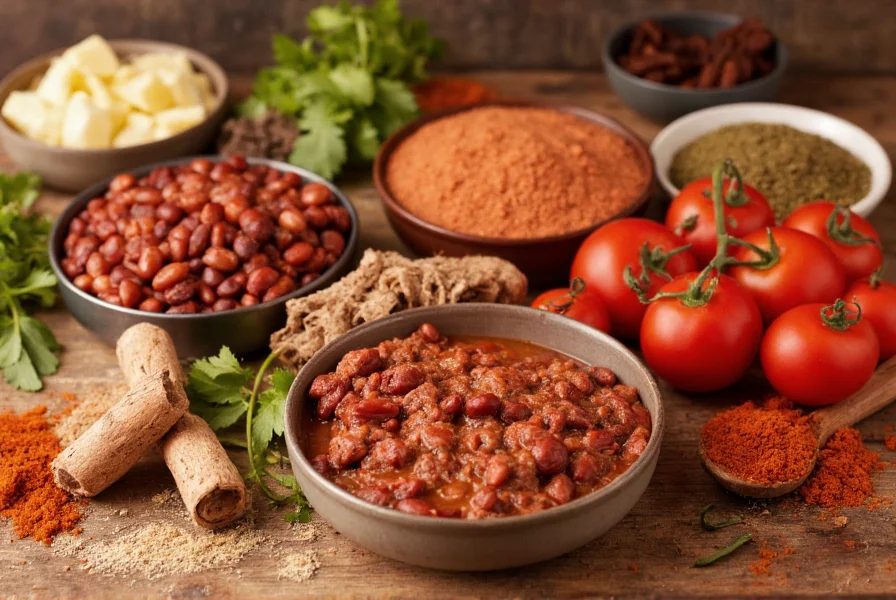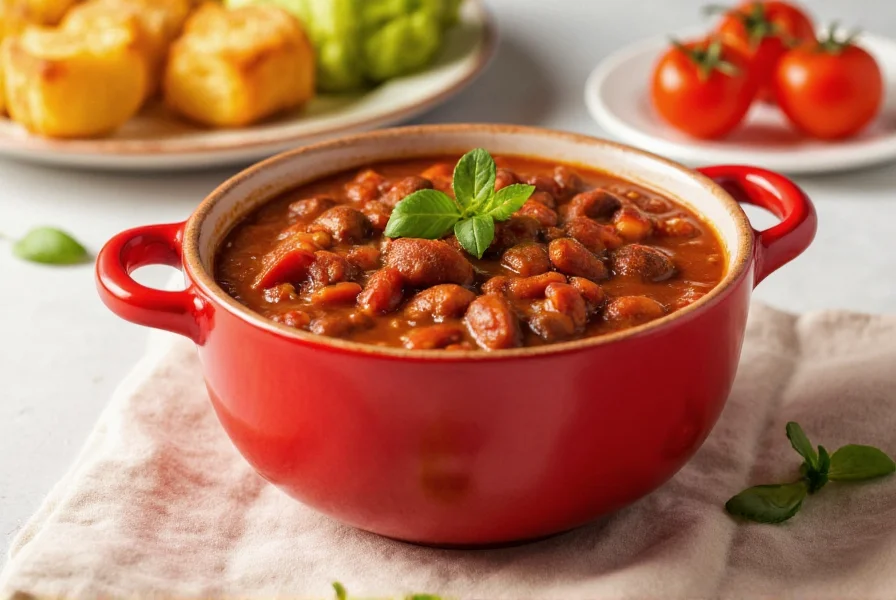When selecting quality canned chili, examine the ingredient list for minimal additives and preservatives. Premium options contain recognizable components like "ground beef," "kidney beans," "tomatoes," and "onion" rather than vague terms like "spices" or "natural flavors." The best canned chili varieties balance protein, fiber, and complex carbohydrates while avoiding excessive sodium and artificial ingredients.
Understanding Canned Chili Varieties
Canned chili comes in several formulations catering to different dietary preferences and taste profiles. Traditional versions feature ground beef with beans, while regional variations might include unique spice blends reflecting local culinary traditions. Understanding these differences helps you select the right product for your needs.
| Type | Key Characteristics | Best For |
|---|---|---|
| Regular Beef Chili | Ground beef, beans, tomatoes, chili spices | Classic chili experience, family meals |
| Beanless Chili | Meat-heavy, no beans, thicker consistency | Texas-style chili enthusiasts |
| Vegetarian Chili | Beans, vegetables, plant-based protein | Meat-free diets, lighter meals |
| Hot & Spicy Chili | Increased heat level, additional peppers | Those preferring bold, fiery flavors |
Nutritional Profile Analysis
Canned chili provides a convenient source of protein and fiber, though nutritional content varies significantly between brands. Most standard servings (about 1 cup) contain 250-350 calories, 12-18 grams of protein, and 8-12 grams of fiber. The primary concerns are sodium content, which often ranges from 600-1,000mg per serving, and added sugars in some formulations.
When evaluating canned chili nutrition facts, prioritize options with:
- At least 10g of protein per serving
- 8g or more of dietary fiber
- Less than 700mg sodium per serving
- No added sugars or artificial preservatives
Five Professional-Grade Enhancements for Canned Chili
Transform basic canned chili into restaurant-quality meals with these chef-approved techniques that address common flavor deficiencies in store-bought varieties.
- Acidity Balance - Stir in 1-2 tablespoons of apple cider vinegar or fresh lime juice after heating. This brightens flavors and cuts through richness, addressing the flat taste common in many canned varieties.
- Umami Boost - Add 1 tablespoon of tomato paste cooked in olive oil for 2-3 minutes before incorporating the chili. This technique develops deeper flavor compounds often missing in mass-produced options.
- Texture Improvement - For bean-heavy varieties, remove one cup of chili, mash it thoroughly, then return it to the pot. This creates a richer, more cohesive texture without altering ingredients.
- Spice Customization - Bloom 1 teaspoon of cumin and 1/2 teaspoon of smoked paprika in oil before adding to chili. This activates flavor compounds more effectively than adding dry spices directly.
- Temperature Control - Simmer enhanced chili for 15-20 minutes rather than boiling. Gentle cooking allows flavors to meld without breaking down delicate ingredients.
Storage Guidelines and Shelf Life
Unopened canned chili maintains peak quality for 2-5 years when stored in a cool, dry place away from direct sunlight. The 'best by' date indicates optimal quality, not safety - properly stored cans remain safe indefinitely though flavor may degrade over time.
After opening, transfer unused portions to an airtight container and refrigerate. Consume within 3-4 days for best quality. For longer storage, freeze portions in freezer-safe containers for up to 6 months. Thaw frozen chili in the refrigerator overnight before reheating.
Safety Considerations
Commercially canned chili undergoes rigorous processing that makes it safe to eat directly from the can after heating. The canning process destroys harmful bacteria and creates an environment where pathogens cannot grow. However, discard any cans showing signs of damage including:
- Bulging ends or sides
- Leaking or corroded areas
- Unusual odors upon opening
- Spurting liquid when opened
Home-canned chili requires different safety protocols and should always be boiled for 10 minutes before consumption due to potential botulism risk.
Common Misconceptions About Canned Chili
Several myths persist about canned chili that affect consumer choices. Understanding these helps make informed decisions:
- "Canned chili contains low-quality meat" - Most brands use USDA-inspected beef meeting the same standards as fresh ground beef.
- "All canned foods lose nutritional value" - The canning process preserves nutrients effectively, with some vitamins actually becoming more bioavailable.
- "Canned chili is always high in sodium" - Many brands now offer reduced-sodium versions (look for "no salt added" or "reduced sodium" labels).
- "Canned chili contains preservatives" - Proper canning creates a sterile environment that doesn't require chemical preservatives.

Practical Applications Beyond the Bowl
Canned chili's versatility extends far beyond traditional serving methods. Creative home cooks use it as a base ingredient in numerous dishes:
- Chili Mac - Combine with cooked elbow macaroni and top with cheddar cheese
- Chili Dogs - Use as topping for hot dogs with diced onions
- Chili Casserole - Layer with cornbread batter and bake for a complete meal
- Stuffed Peppers - Fill bell peppers with chili mixture and bake until tender
- Chili Tacos - Use as taco filling with traditional toppings

Conclusion
Canned chili represents one of the most versatile convenience foods available, offering nutritional benefits and culinary flexibility when selected and prepared thoughtfully. By understanding ingredient quality markers, implementing simple enhancement techniques, and applying proper storage methods, home cooks can transform basic canned chili into restaurant-quality meals that satisfy diverse palates while saving significant preparation time.
Frequently Asked Questions
Can you eat canned chili directly from the can without heating?
Yes, commercially canned chili is safe to eat without heating as the canning process fully cooks the contents. However, heating improves both flavor and texture. Always transfer contents to a cooking vessel rather than heating the can directly, which could release harmful chemicals from the can lining.
How can I reduce the sodium content in canned chili?
Rinse beans thoroughly if using bean-heavy varieties, choose "no salt added" options when available, and dilute with low-sodium tomato juice or broth. Adding potassium-rich ingredients like extra vegetables can also help balance sodium effects. Many premium brands now offer reduced-sodium versions containing 30-50% less salt than standard varieties.
What's the best way to freeze canned chili for long-term storage?
Portion cooled chili into freezer-safe containers or heavy-duty zip-top bags, leaving 1-inch headspace for expansion. For bags, lay flat to freeze for space-efficient stacking. Properly frozen chili maintains quality for 4-6 months. Thaw overnight in the refrigerator before reheating gently on the stove to preserve texture.
Which canned chili varieties work best for vegetarian diets?
Look for explicitly labeled vegetarian or vegan chili varieties that use plant-based proteins instead of meat. Many quality brands offer bean-centric options with textured vegetable protein or lentils as meat substitutes. Always check ingredient lists for hidden animal products like chicken stock or beef fat, which sometimes appear in products labeled "vegetarian style" but not certified vegetarian.











 浙公网安备
33010002000092号
浙公网安备
33010002000092号 浙B2-20120091-4
浙B2-20120091-4